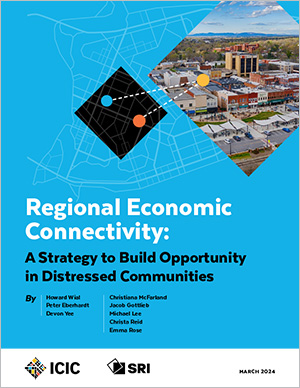Research
30 Years of Research
ICIC was established in 1994 as a research organization. For 30 years, ICIC has conducted research to help public, private, nonprofit, and community leaders understand and respond to the community and economic development challenges facing under-resourced communities (URCs). Under-resourced communities include communities of concentrated poverty in both the central cities and suburbs of metropolitan areas. Our unique knowledge of these communities’ strengths and challenges is developed from path-breaking research, consulting, and practice. Our research agenda, which encompasses community and economic development, small business and entrepreneurship, industries and clusters, anchor initiatives, and program evaluation, has positioned ICIC as the leading and most trusted resource on under-resourced communities and their economies.
Why Research?
Research has been a core part of ICIC’s approach to creating impact since its founding 30 years ago. ICIC’s initial research focused on identifying and promoting the competitive advantages of “inner cities” at a time when researchers and the public were largely focused on the challenges facing these communities. Over the following three decades, ICIC’s research agenda has expanded to include diverse topic areas such as small business and entrepreneurship, anchor institutions, and program evaluation. Research provides ICIC with a unique ability to identify and evaluate effective inclusive development strategies. Our research team is motivated by the belief that economic and community development in under-resourced communities should make the current residents of those communities better off economically and socially and that it should reflect their priorities.

Recent Publications
Regional Economic Connectivity
Regional economic connectivity is an economic, workforce, and community development strategy that focuses on industry clusters that are thriving in the broader region and establishing them within URCs. To better understand how well and under which circumstances distressed communities benefit from regional economic connectivity, ICIC and SRI examined geographic patterns of industry cluster employment in 181 metropolitan areas. Our report Regional Economic Connectivity: A Strategy to Build Opportunity in Distressed Communities describes the features of economic connectivity, demonstrates how connectivity has been achieved for a diverse set of industry clusters in five metropolitan areas and draws conclusions for economic development policy and practice. The report and its accompanying data dashboard indicate significant opportunity for economic developers and their partners to target asset development and other strategic investments to grow regionally strong clusters in URCs.
Racial Equity in America’s New Industrial Transformation
The U.S. is on the cusp of a groundbreaking moment. Three pieces of federal legislation enacted in 2021 and 2022—the Infrastructure Investment and Jobs Act, the CHIPS and Science Act, and the Inflation Reduction Act—collectively authorize nearly $1.5 trillion in an effort to reshape America’s industrial landscape while meeting the nation’s critical infrastructure, high-technology, and clean energy needs.
Racial Equity in America’s New Industrial Transformation uncovers a deeply concerning reality: Black-owned and Hispanic-owned manufacturers account for only 0.5% and 0.8%, respectively, of all manufacturers across 13 critical supply chains supported by the three pieces of legislation. By mapping the current landscape and proposing actionable strategies, this study provides the information and policy recommendations needed to make America’s industrial renewal more equitable.
Industrial and Non-Industrial Jobs and Land Use in Saint Paul, MN
For two years, ICIC worked with the Saint Paul Port Authority to research industrial land use and employment patterns in Saint Paul. Our report Industrial and Non-Industrial Jobs and Land Use in Saint Paul, MN includes an analysis of the impact of each type of land use in Saint Paul on the city’s budget, an outline of the broad industrial employment trends, an examination of the geographic distribution of industrial jobs in the city, and more. It finds that:
- Properties occupied by light industrial land use are important players in funding the city budget.
- Jobs in industrial sectors consistently paid higher average wages than jobs in non-industrial sectors every year from 2008 to 2022.
- Industrial jobs are decentralizing from Saint Paul’s industrial zones.
- Businesses located in the Port Authority’s business centers have an enormous economic impact on the local economy; in 2022, they supported $9.3 billion in economic activity in the city through direct, indirect, and induced spending.
Partner Spotlight

“Small Business Majority has a strong, mission-aligned partnership with ICIC, rooted in a shared commitment to helping small businesses overcome systemic obstacles. From early-pandemic relief webinars to our current research on structural barriers that impact entrepreneurs, this collaboration exemplifies how organizations can combine strengths to provide underserved small businesses with essential resources, support, and advocacy. Together, we’re paving the way toward a more equitable economy where small businesses in vulnerable communities have genuine opportunities to thrive.”
Brian Pifer, Vice President of Research and Insights
Small Business Majority

“Underserved communities are places with rich assets, perspectives, and knowledge. I’m driven to help all communities lead with their strengths. SRI’s partnership with ICIC, through our economic connectivity research, helps us to understand the disparate impacts of significant economic and industrial change driven by innovation and to give underserved communities a seat at the table to create strategies and policies that honor their strengths and ensure participation in the tech-based economy.”
Christiana McFarland, Director
Center for Innovation Strategy and Policy
SRI


